Scientist of the Day - André Tacquet
André Tacquet, a Flemish mathematician and Jesuit priest, was born June 23, 1612, in Antwerp. A contributor to the Wikipedia article on Tacquet wrote: “Tacquet became a brilliant mathematician of international fame and his works were often reprinted and translated (into Italian and English),” a comment probably written by a modern Jesuit untrained in the history of science. Tacquet was neither brilliant nor famous, although he was certainly learned, and the only work of his that was translated into English was his selection of theorems from Euclid, and one has to believe that it was Euclid who was the focus of the translation, not Tacquet. Tacquet was like dozens of his brethren who taught science and mathematics in Jesuit colleges all over Europe: intelligent, well-educated, hard-working, prolific, and completely out of touch with the intellectual revolution swirling all around them.
But I like the Jesuit scientists of the 17th century, because they thought emblematically. They saw the world as an elaborate code, written by God and awaiting decipherment by members of the Society of Jesus. Everything had meaning, usually a double or triple meaning, since the Jesuit world was a web of sympathies, associations, and correspondences. Consequently, nearly every Jesuit scientific book has an emblematic titlepage that uses visual metaphors drawn from emblem books, personification books, mythology, and of course Scripture, to tell some kind of a story, in cipher. The books by Athansasius Kircher on optics, magnetism, and geology, have especially rich introductory engravings, as do those by Christoph Scheiner, Giovanni Battista Riccioli, Mario Bettini, and Niccolò Zucchi, all of which we have discussed at some point in this series, and a host of others awaiting their moment in the emblematic Sun.
Books on mathematics evoke fewer emblematic associations, but a clever Jesuit can still create a visual tableau that enriches the text, and Tacquet certainly did so with two of his books, Cylindricorum et annularium libri IV (Four books on cylinders and rings, 1651) and Opera mathematica (1669) that we have in our collections. For each of these, Tacquet deployed a battery of putti – young, winged, lab assistants that engage in a variety of tasks appropriate for the book they introduce. François Aguilon first introduced the putto to Jesuit emblematic imagery in 1613, with the marvelous headpieces for his book on optics, designed by Peter Paul Rubens. Jesuits have been fond of putti ever since.
Tacquet’s Opera, since it contains all his geometrical treatises, has rather generic geometric imagery on its engraved titlepage. We show a detail of the foreground (first image), and the complete engraving (second image). The putti in the foreground are good Euclidean putti, showing the viewer how to use a compass and a straightedge; there are pithy mottoes attached to each scene, the one at bottom right reminding us that a straight line is the shortest distance between two points. The putti in the background wield decidedly non-Euclidean instruments, Jacob’s staffs and astrolabes, as they demonstrate “mixed mathematics,” the practical sciences that geometry makes possible.
The book on cylinders and rings is about conic sections, which you can produce by slicing a cylinder, a ring, a sphere, or a cone at different angles. On the titlepage, the putti engage in more specific tasks, showing, for example, the different conic sections one can produce by slicing a cylinder. Again, we show both the complete engraving (third image), and a detail of the putti-rich foreground (fourth image). A sphere has also been marked for cutting. The large ring at the top is unsliced, perhaps because the grown-up angels that hold it were untrained in the mathematical arts when they were putti.
You might notice that among the putti at the bottom (fourth image), most have baby-bird-like wings, but three have the wings of a dragonfly. I have never figured out the significance of this. Are they in some kind of angel instar stage, with larval wings? This is not unique to Tacquet – I have noticed other emblematic title pages with insect-winged putti, some non-Jesuit. I have no idea what it means.
Finally, to give Taquet some well-deserved credit for innovation, the text engravings in his book on cylinders and rings are beautifully executed, with added shading to produce a three-dimensional effect (fifth image). Most diagrams in geometry books of the period were flat, boring, and hard to read, as you can see from a more conventional diagram in Book Five of his treatise, which was added in 1659 (sixth image), and for some reason did not continue in the innovative style of the first four books.
Tacquet gets no credit for the binding of our copy of the book on cylinders and rings, but I thought I would show it to you anyway, since it is beautiful, in stamped vellum with clasps, and the owner’s crest stamped in the center, just waiting to be identified by some interested scholar (seventh image).
William B. Ashworth, Jr., Consultant for the History of Science, Linda Hall Library and Associate Professor emeritus, Department of History, University of Missouri-Kansas City. Comments or corrections are welcome; please direct to ashworthw@umkc.edu.


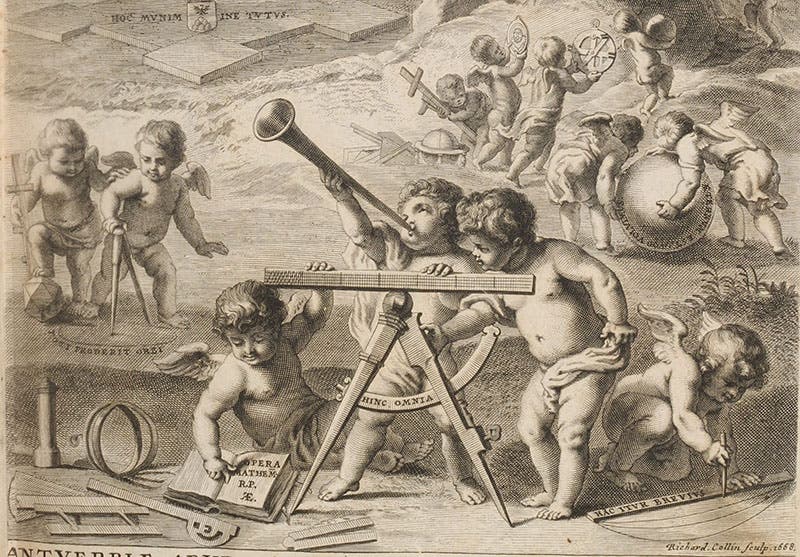

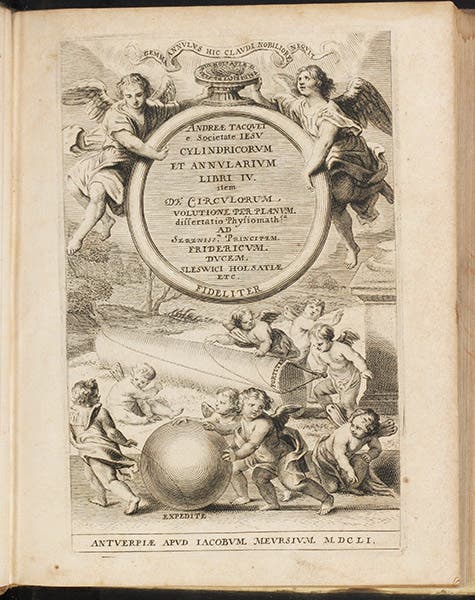
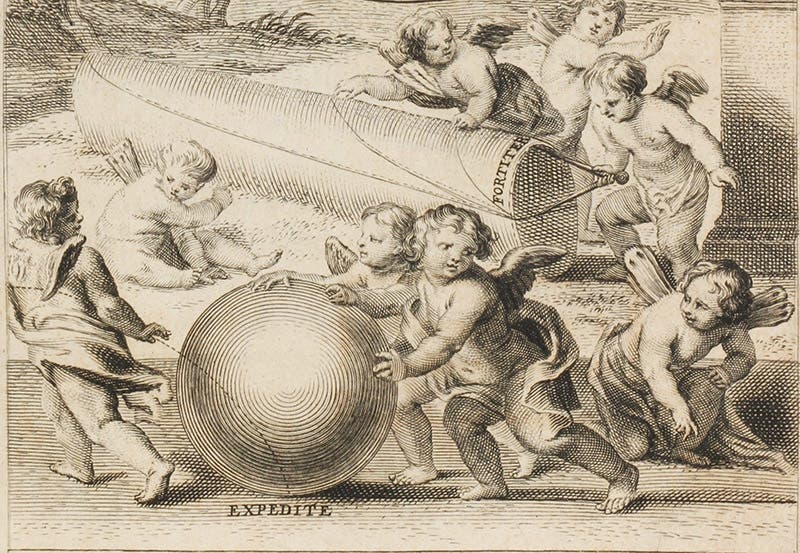
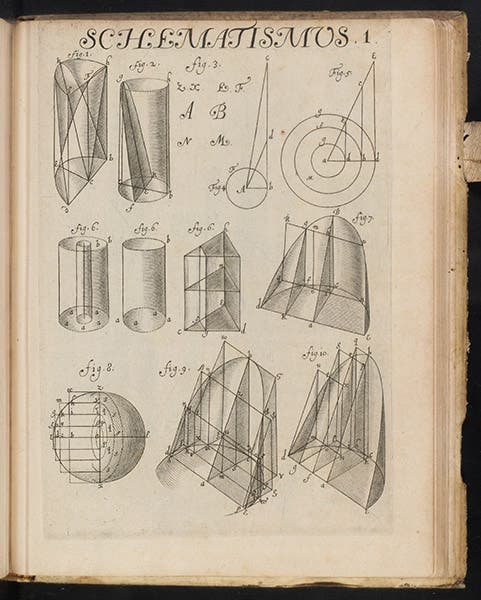
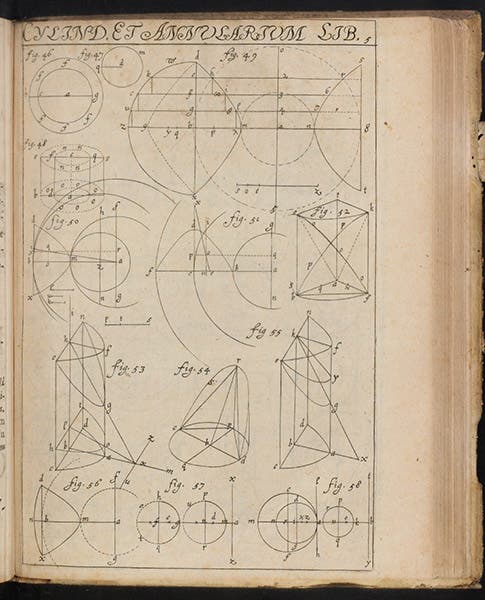
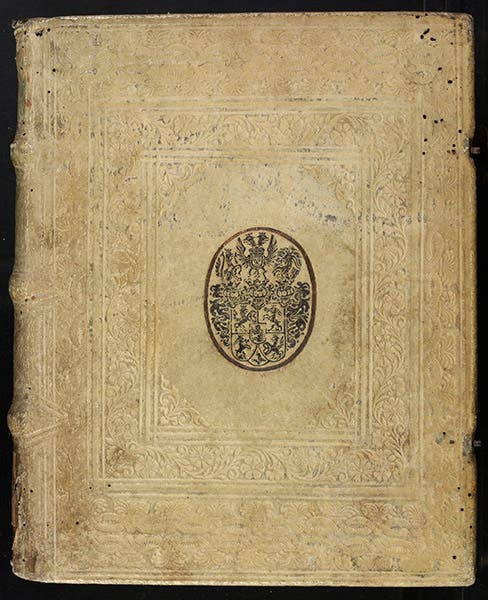



![Columbine, hand-colored woodcut, [Gart der Gesundheit], printed by Peter Schoeffer, Mainz, chap. 162, 1485 (Linda Hall Library)](https://assets-us-01.kc-usercontent.com:443/9dd25524-761a-000d-d79f-86a5086d4774/3829b99e-a030-4a36-8bdd-27295454c30c/gart1.jpg?w=210&h=210&auto=format&fit=crop)
